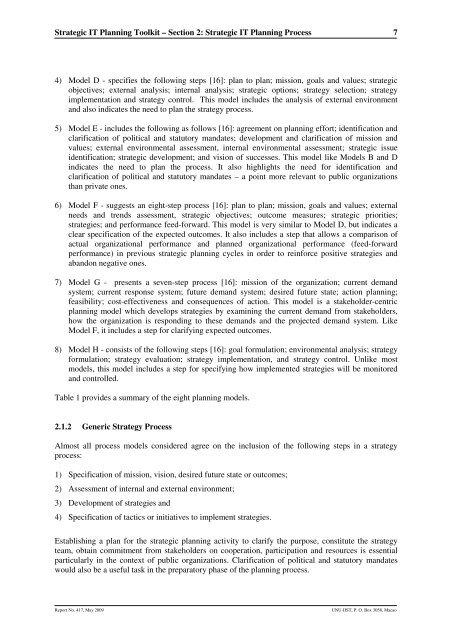Strategic IT Planning for Public Organizations: A Toolkit - UNU-IIST ...
Strategic IT Planning for Public Organizations: A Toolkit - UNU-IIST ...
Strategic IT Planning for Public Organizations: A Toolkit - UNU-IIST ...
Create successful ePaper yourself
Turn your PDF publications into a flip-book with our unique Google optimized e-Paper software.
<strong>Strategic</strong> <strong>IT</strong> <strong>Planning</strong> <strong>Toolkit</strong> – Section 2: <strong>Strategic</strong> <strong>IT</strong> <strong>Planning</strong> Process<br />
7<br />
4) Model D - specifies the following steps [16]: plan to plan; mission, goals and values; strategic<br />
objectives; external analysis; internal analysis; strategic options; strategy selection; strategy<br />
implementation and strategy control. This model includes the analysis of external environment<br />
and also indicates the need to plan the strategy process.<br />
5) Model E - includes the following as follows [16]: agreement on planning ef<strong>for</strong>t; identification and<br />
clarification of political and statutory mandates; development and clarification of mission and<br />
values; external environmental assessment, internal environmental assessment; strategic issue<br />
identification; strategic development; and vision of successes. This model like Models B and D<br />
indicates the need to plan the process. It also highlights the need <strong>for</strong> identification and<br />
clarification of political and statutory mandates – a point more relevant to public organizations<br />
than private ones.<br />
6) Model F - suggests an eight-step process [16]: plan to plan; mission, goals and values; external<br />
needs and trends assessment, strategic objectives; outcome measures; strategic priorities;<br />
strategies; and per<strong>for</strong>mance feed-<strong>for</strong>ward. This model is very similar to Model D, but indicates a<br />
clear specification of the expected outcomes. It also includes a step that allows a comparison of<br />
actual organizational per<strong>for</strong>mance and planned organizational per<strong>for</strong>mance (feed-<strong>for</strong>ward<br />
per<strong>for</strong>mance) in previous strategic planning cycles in order to rein<strong>for</strong>ce positive strategies and<br />
abandon negative ones.<br />
7) Model G - presents a seven-step process [16]: mission of the organization; current demand<br />
system; current response system; future demand system; desired future state; action planning;<br />
feasibility; cost-effectiveness and consequences of action. This model is a stakeholder-centric<br />
planning model which develops strategies by examining the current demand from stakeholders,<br />
how the organization is responding to these demands and the projected demand system. Like<br />
Model F, it includes a step <strong>for</strong> clarifying expected outcomes.<br />
8) Model H - consists of the following steps [16]: goal <strong>for</strong>mulation; environmental analysis; strategy<br />
<strong>for</strong>mulation; strategy evaluation; strategy implementation, and strategy control. Unlike most<br />
models, this model includes a step <strong>for</strong> specifying how implemented strategies will be monitored<br />
and controlled.<br />
Table 1 provides a summary of the eight planning models.<br />
2.1.2 Generic Strategy Process<br />
Almost all process models considered agree on the inclusion of the following steps in a strategy<br />
process:<br />
1) Specification of mission, vision, desired future state or outcomes;<br />
2) Assessment of internal and external environment;<br />
3) Development of strategies and<br />
4) Specification of tactics or initiatives to implement strategies.<br />
Establishing a plan <strong>for</strong> the strategic planning activity to clarify the purpose, constitute the strategy<br />
team, obtain commitment from stakeholders on cooperation, participation and resources is essential<br />
particularly in the context of public organizations. Clarification of political and statutory mandates<br />
would also be a useful task in the preparatory phase of the planning process.<br />
Report No. 417, May 2009<br />
<strong>UNU</strong>-<strong>IIST</strong>, P. O. Box 3058, Macao

















